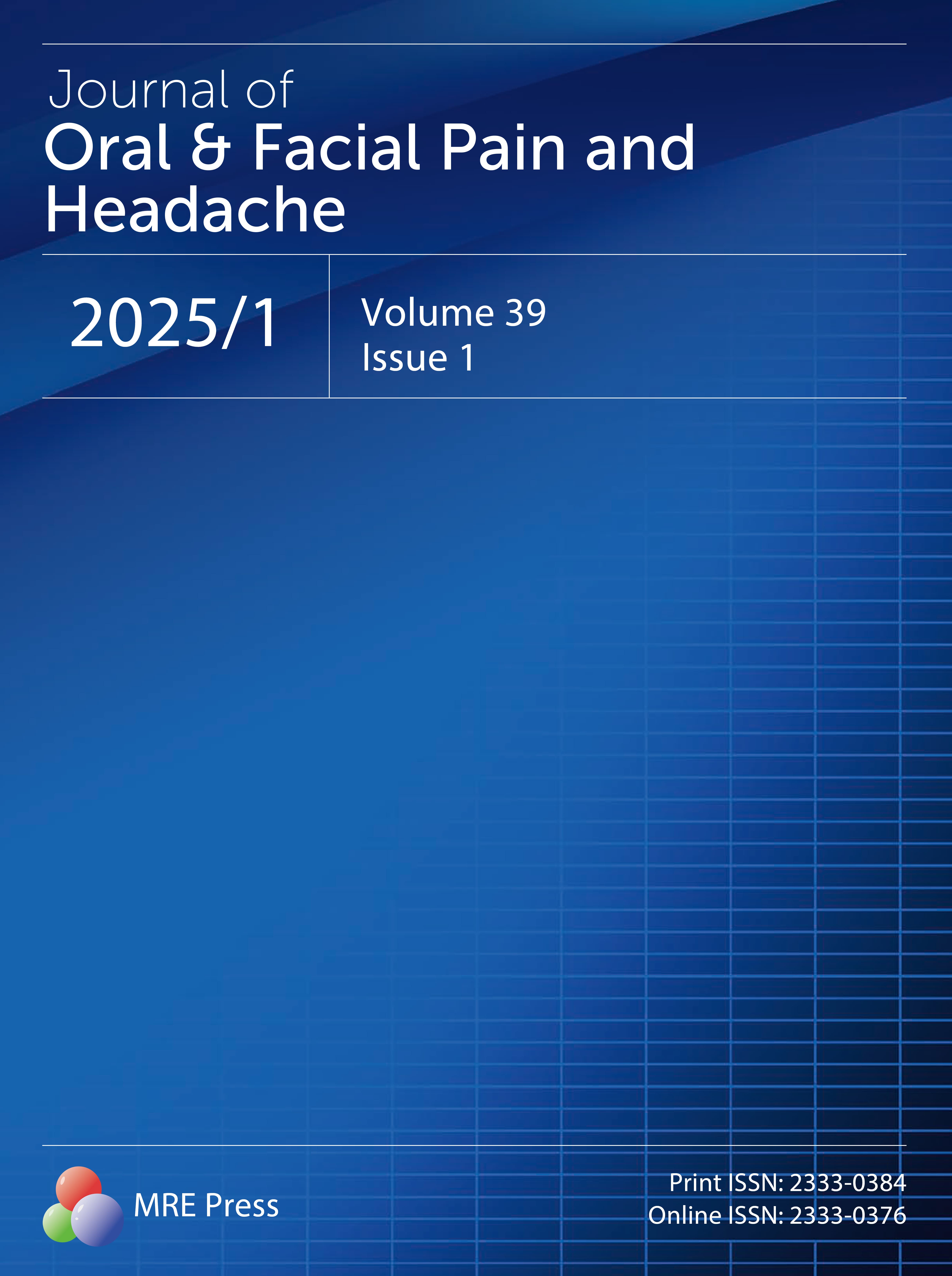Title
Author
DOI
Article Type
Special Issue
Volume
Issue
Article Menu
Export Article
More by Authors Links
Article Data
- Views 788
- Dowloads 53
Journal of Oral & Facial Pain and Headache (OFPH) is published by MRE Press from Volume 38 lssue 1 (2024). Previous articles were published by another publisher on a subscription basis, and they are hosted by MRE Press on www.jofph.com as a courtesy and upon agreement with Journal of Oral & Facial Pain and Headache.
Original Research
Open AccessEffect of Dexamethasone and Dipyrone on Lingual and Inferior Alveolar Nerve Hypersensitivity Following Third Molar Extractions: Preliminary Report
Effect of Dexamethasone and Dipyrone on Lingual and Inferior Alveolar Nerve Hypersensitivity Following Third Molar Extractions: Preliminary Report
- Robert P. Barron1,*,
- Raphael Benoliel2
- Raphael Zeltser3
- Eli Eliav2
- Oded Nahlieli3,4
- Richard H. Gracely5
1Thornhill, Ontario, Canada
2Department of Oral Medicine, The Hebrew University School of Dental Medicine, Hadassah Medical Center, Jerusalem, Israel
3Department of Oral and Maxillofacial Surgery, The Hebrew University School of Dental Medicine, Hadassah Medical Center, Jerusalem, Israel
4Department of Oral and Maxillofacial Surgery, Barzilai Medical Centre, Ashkelon, Israel
5Chronic Pain and Fatigue Research Program, University of Michigan Health System, Veterans Administration Medical Center, Ann Arbor, Michigan
*Corresponding Author(s): Robert P. Barron E-mail: rbarron@rogers.com
Abstract
Aims: To study the effect of dexamethazone and dipyrone on sen-sory changes in the innervation territories of the inferior alveolar, infraorbital, and lingual nerves caused by third molar extractions. Methods: Fourteen patients (8 men and 6 women) were divided randomly into 2 groups. The first group received dipyrone preop-eratively, while the second group received dipyrone and dexamet-hazone preoperatively. All patients in the study received a prophy-lactic preoperative dose of amoxicillin (500 mg) as well as dipyrone postoperatively. In all patients, a single mandibular third molar was removed, while in 2 patients the contralateral third molar was removed at a subsequent time. Electrical detection thresholds were assessed in the inferior alveolar, lingual, and infraorbital nerve regions prior to surgery and 2 and 8 days fol-lowing surgery. The level of perioperative pain, difficulty of extraction, and distance of molar root apices from the inferior alveolar nerve canal were also assessed. Results: Patients who received only dipyrone had significantly reduced lingual and infe-rior alveolar nerve electrical detection thresholds 2 days after surgery, which returned to nearly baseline values by the eighth day postoperatively. In patients who received dexamethasone, no sig-nificant reduction in the electrical detection threshold was found. Conclusion: Preoperative treatment with dexamethasone and dipyrone but not dipyrone alone prevents sensory hypersensitivity following third molar extraction.
Keywords
dexamethasone; dipyrone; pain measurement; third molar; tooth extraction
Cite and Share
Robert P. Barron, Raphael Benoliel, Raphael Zeltser, Eli Eliav, Oded Nahlieli, Richard H. Gracely. Effect of Dexamethasone and Dipyrone on Lingual and Inferior Alveolar Nerve Hypersensitivity Following Third Molar Extractions: Preliminary Report. Journal of Oral & Facial Pain and Headache. 2004. 18(1);62-68.
References
1. Eliav E, Gracely RH. Sensory changes in the territory of the lingual and inferior alveolar nerves following lower third molar extraction. Pain 1998;77:191–199.
2. Troullos ES, Hargreaves KM, Butler DP, Dionne RA. Comparison of non-steroidal antiinflammatory drugs, ibuprofen and flurbiprofen, with methylprednisolone for acute pain, swelling and trismus. J Oral Maxillofac Surg 1990;48:945–952.
3. Neumann S, Doubell TP, Leslie T, Woolf CJ. Inflam-matory pain hypersensitivity mediated by phenotypic switch in myelinated primary sensory neurons. Nature 1996;384:360–364.
4. Ma QP, Woolf CJ. Progressive tactile hypersensitivity: An inflammation-induced incremental increase in the excitability of the spinal cord. Pain 1996;67:97–106.
5. Mitchell DA. A controlled clinical trial of prophylactic tinidazole for chemoprophylaxis in third molar surgery. Br Dent J 1986;160:284–286.
6. Smith WI, Marnett LJ. Prostaglandin endoperoxide synthase; Structure and catalysis. Biochim Biophys Acta 1991;1083:1–17.
7. Esen E, Tasar F, Akhan O. Determination of the antiinflammatory effects of methylprednisone on the sequelae of third molar surgery. J Oral Maxillofac Surg 1999;57: 1201–1206.
8. Gilman AG, Goodman LS, Rall TW, Murad F. Goodman and Gilman’s The Pharmacological Basis of Therapeutics, ed 7. New York: Macmillan, 1985:690–692.
9. Harrison TR, Fauci AS, Braunwald E, et al. Harrison’s Principles of Internal Medicine, ed 14, vol 1. New York: McGraw-Hill, 1998:663–665.
10. Dionne RA, Mitchell SM, Parada S, et al. The substance P receptor antagonist CP-99, 994 reduces acute postoperative pain. Clin Pharmacol Ther 1998;64:562–568.
11. Gracely RH, Price DD, Roberts WJ, Bennett GJ. Quantitative sensory testing in patients with CRPS-I & II. In: Janig W, Stanton-Hicks M (eds). Reflex Sympathetic Dystrophy: A Reappraisal. Seattle: IASP Press, 1996: 151–172.
12. Collins WF Jr, Nulsen FE, Randt CT. Relation of periph-eral nerve fiber size and sensation in man. Arch Neurol 1960;3:381–385.
13. Ma QP, Woolf CJ. Tachykinin NK1 receptor RP67580 attenuates progressive hypersensitivity of flexor reflex during experimental inflammation in rats. Eur J Pharmacol 1997;322:165–171.
14. Eliav E, Herzberg U, Ruda MA, Bennett GJ. Neuropathic pain from an experimental neuritis of the rat sciatic nerve. Pain 1999;83:169–182.
15. Eliav E, Benoliel R, Tal M. Inflammation with no axonal damage of the rat saphenous nerve trunk induces ectopic discharge and mechanosensitivity in myelinated axons. Neurosci Lett 2001;311:49–52.
16. Mizobuchi K, Kuwabara S, Toma S, Nakamija Y, Oga-wara K, Hattori T. Properties of human skin mechanore-ceptors in peripheral neuropathy. Clin Neurophysiol 2002;113:310–315.
17. Sessle BJ. The neural basis of temporomandibular joint and masticatory muscle pain. J Orofac Pain 1999;13: 238–245.

Abstracted / indexed in
Science Citation Index (SCI)
Science Citation Index Expanded (SCIE)
BIOSIS Previews
Scopus
Cumulative Index to Nursing and Allied Health Literature (CINAHL)
Submission Turnaround Time
Editorial review: 1 - 7 days
Peer review: 1 - 3 months
Publish Ahead of Print: within 2 months after being accepted
Notes: Your information is kept confidential throughout the review process.
Top
